Leiden 作者: 来源: 发布时间:2021-04-28
一、所属省或是州,具体位置,人口,面积
Country Netherlands
Province South Holland
Government
• Body Municipal council
• Mayor Henri Lenferink (PvdA)
Area
• Municipality 23.27 km2 (8.98 sq mi)
• Land 21.95 km2 (8.47 sq mi)
• Water 1.32 km2 (0.51 sq mi)
Elevation 0 m (0 ft)
Population (Municipality, January 2019; Urban and Metro, May 2014)
• Municipality 124,899
• Density 5,690/km2 (14,700/sq mi)
• Urban 258,923
• Metro 344,299
Demonym(s) Leidenaar
Time zone UTC+1 (CET)
• Summer (DST) UTC+2 (CEST)
Postcode 2300–2334
Area code 071
Leiden is a city and municipality in the province of South Holland, Netherlands. The municipality of Leiden had a population of 123,856 in August 2017, but the city forms one densely connected agglomeration with its suburbs Oegstgeest, Leiderdorp, Voorschoten and Zoeterwoude with 206,647 inhabitants. The Netherlands Central Bureau of Statistics (CBS) further includes Katwijk in the agglomeration which makes the total population of the Leiden urban agglomeration 270,879, and in the larger Leiden urban area also Teylingen, Noordwijk, and Noordwijkerhout are included with in total 348,868 inhabitants. Leiden is located on the Oude Rijn, at a distance of some 20 kilometres (12 miles) from The Hague to its south and some 40 km (25 mi) from Amsterdam to its north. The recreational area of the Kaag Lakes (Kagerplassen) lies just to the northeast of Leiden.
A university city since 1575, Leiden has been one of Europe's most prominent scientific centres for more than four centuries. Leiden is a typical university city, university buildings are scattered throughout the city and the many students from all over the world give the city a bustling, vivid and international atmosphere. Many important scientific discoveries have been made here, giving rise to Leiden's motto: ‘City of Discoveries’. The city houses Leiden University, the oldest university of the Netherlands, and Leiden University Medical Center. Leiden University is one of Europe's top universities, with thirteen Nobel Prize winners. It is a member of the League of European Research Universities and positioned highly in all international academic rankings. It is twinned with Oxford, the location of the United Kingdom's oldest university. Leiden University and Leiden University of Applied Sciences (Leidse Hogeschool) together have around 35,000 students. Modern scientific medical research and teaching started in the early 18th century in Leiden with Boerhaave.
Leiden is a city with a rich cultural heritage, not only in science, but also in the arts. One of the world's most famous painters, Rembrandt, was born and educated in Leiden. Other famous Leiden painters include Lucas van Leyden, Jan van Goyen and Jan Steen.

二、自然地理(地理环境、自然资源,交通情况)
Rivers, canals and parks
The two branches of the Oude Rijn, which enter Leiden on the east, unite in the centre of the city. The city is further intersected by numerous small canals with tree-bordered quays. On the west side of the city, the Hortus Botanicus and other gardens extend along the old Singel, or outer canal. The Leidse Hout park, which contains a small deer park, lies on the northwest border with Oegstgeest. The Van der Werf Park is named after the mayor Pieter Adriaansz. van der Werff [nl], who defended the city against the Spaniards in 1574. The city was beleaguered for months and many died from famine. The open space for the park was formed by the accidental explosion of a ship loaded with gunpowder in 1807, which destroyed hundreds of houses, including that of the Elsevier family of printers.
Public transport
Bus transport in Leiden is provided by Arriva.
Railway stations within the municipality of Leiden are:
Leiden Centraal
Leiden Lammenschans
De Vink
三、产业特点/重点项目
Companies based in Leiden
FlexGen B.V.
Industry Biotechnology
Founded 2004
Headquarters Leiden, Netherlands
Area served
Worldwide
Products FlexArrayer, FleXelect custom oligopools
Services Custom oligopool synthesis
Airbus SE
Formerly
Pre-2017 parent company:
European Aeronautic Defence and Space Company NV (2000–2014), Airbus Group NV (2014–2015), Airbus Group SE (2015–2017)
Pre-2017 subsidiary:
Airbus Industrie GIE (1970–2001), Airbus SAS (2001–2017)
Type
Societas Europaea (SE)
Traded as Euronext Paris: AIR
BMAD: AIR
FWB: AIR
CAC 40 Component
Euro Stoxx 50 component
ISIN NL0000235190
Industry Aerospace, Defence
Predecessor Aérospatiale-Matra, DASA, and CASA
Founded 18 December 1970; 49 years ago (as Airbus Industrie GIE)
Founder Roger Béteille, Felix Kracht, Henri Ziegler, Franz Josef Strauss
Headquarters
Blagnac, Greater Toulouse, France (main office)
Leiden, Netherlands (headquarters)
Barcelona, Spain (international office)
Area served
Worldwide
Key people
René Obermann (Chairman)
Guillaume Faury (CEO)
Products Civilian A220, A300, A310, A318, A319, A320, A321, A330, A340, A350, A380
unmanned aerial vehicles
Revenue Increase €70.5 billion (2018)
Operating income
Increase €5.04 billion (2018)
Net income
Increase €3.05 billion (2018)
Total assets Increase €115.19 billio (2018)
Total equity Decrease €9.72 billion(2018)
Owner As of 31 December 2019:
SOGEPA (France): 11.0%
GZBV (Germany): 10.9%
SEPI (Spain): 4.1%
Others: 74.0%
Number of employees
133,671 (2018)
Divisions Airbus Defence and Space SAS
Airbus Helicopters SAS
Subsidiaries
Airbus Group, Inc.
Airbus Corporate Jets
Airbus Operations S.A.S.
Navblue
Stelia Aerospace
Airbus Transport International
Testia
Website www.airbus.com
Airbus's registered headquarters is in Leiden, Netherlands, with the operating head office located in Toulouse.
In the late 1990s Airbus became increasingly interested in developing and selling to the military aviation market. It embarked on two main fields of development: aerial refuelling with the Airbus A310 MRTT (Multi-Role Tanker Transport) and the Airbus A330 MRTT, and tactical airlift with the Airbus A400M Atlas.
Leiden Bio Science Park
Location Leiden, South Holland, Netherlands
Address J.H. Oortweg 19, 2333CH Leiden
Coordinates 52°10′3″N 4°27′56.88″E
Opening date 1984
Owner Municipality of Leiden, Leiden University and Leiden University Medical Center
No. of workers 19,000
Size 272 acres
Website http://leidenbiosciencepark.nl
The Leiden Bio Science park (LBSP) is the largest life sciences cluster in the Netherlands and ranks in the top five of the most successful science parks in Europe. It is part of Leiden and Oegstgeest and focuses on companies and universities in the Biotechnology sector.
The park comprises 110 hectares (272 acres) with over 103 companies and knowledge-based institutions. The park is located mostly in Leiden and lies between Wassenaarseweg on the north and the Plesmanlaan on the south.
The park focuses mostly on the use of biotechnology for medical and biopharmaceutical applications.
Research and Education
Alrijne Ziekenhuis Leiden
Biotech Training Facility
Boerhaave Nascholing
Centre of Human Drug Research (CHDR)
Centre for Science and Technology Studies (CWTS)
Corpus museum
Dutch Institute for Clinical Auditing (DICA)
Leiden Academic Centre for Drug Research (LACDR)
Leiden instrumentmakers School (LiS)
Leiden University
Leiden University Medical Center (LUMC)
MBO Rijnland, Laboratory studies
Naturalis Biodiversity Center
Netherlands Organisation for Applied Scientific Research (TNO)
University of Applied Sciences Leiden (UAS Leiden)
The Environment Act will be introduced throughout the Netherlands in early 2021. The Environmental Act bundles and simplifies legislation and regulations in the field of environmental law. It is the biggest revision of laws and regulations ever! (Leiden environmental act holland)

The Heart of Holland: regional agenda for the 2040 environmental vision
The Board of Mayor and Aldermen has adopted Het Hart van Holland, the regional agenda for the 2040 environmental vision, and released it for public participation.
Leiden environmental vision selected as pilot environmental law
Together with nine surrounding municipalities, Leiden has drawn up the regional agenda for the 2040 Het Hart van Holland environmental vision.
四、风景名胜,景点

Rijksmuseum Boerhaave, Netherlands' treasure house of science and medicine
The museum is winner of the European Museum of the Year Award.
Address: National Museum Boerhaave
10, Lange St. Agnietenstraat, 2312 WC Leiden
+31 71 - 751 99 99
info@rijksmuseumboerhaave.nl
https://rijksmuseumboerhaave.nl/

Hortus Botanicus Leiden in 1610. Print by Jan Cornelisz. Woudanus and Willem Isaacsz. van Swanenburg.
Hortus Botanicus Leiden
The Hortus botanicus of Leiden is the oldest botanical garden of the Netherlands, and one of the oldest in the world. It is located in the southwestern part of the historical centre of the city, between the Academy building and the old Leiden Observatory building.
History
In 1587 the young University of Leiden asked for permission from the mayor of Leiden to establish a hortus academicus behind the university building, for the benefit of the medical students. The request was granted in 1590, and the famous botanist Carolus Clusius (1526–1609) was appointed as prefect. Clusius arrived in Leiden in 1593. His knowledge, reputation, and international contacts allowed him to set up a very extensive plant collection. Clusius also urged the Dutch East India Company (VOC) to collect plants and (dried) plant specimens in the colonies. The original garden set up by Clusius was small (about 35 by 40 meters), but contained more than 1000 different plants.
The collecting of tropical (from the Indies) and sub-tropical (from the Cape Colony) plants was continued under Clusius' successors. Especially Herman Boerhaave (1668–1738, prefect from 1709–1730), contributed greatly to the fame of the Hortus with his efforts to collect new plants and specimens, and with his publications, such as a catalog of the plants then to be found in the Hortus.
Another major contribution to the collections was made by Philipp Franz von Siebold, a German physician who was employed on Deshima (Japan) by the VOC from 1823 until his expulsion by Japan in 1829. During that period he collected many dried and living plants from all over Japan (as well as animals, ethnographical objects, maps, etc.), and sent them to Leiden.
The first greenhouses appeared in the Hortus in the second half of the 17th century, the monumental Orangery was built between 1740 and 1744. From its original plan the Hortus was expanded in 1736 by Adriaan van Royen and Carl Linnaeus, and in 1817 by Theodor Friedrich Ludwig Nees von Esenbeck and Sebald Justinus Brugmans. In 1857, a part was used for building the new Leiden Observatory.

De Valk (2007)
De Valk is a tower mill and museum in Leiden, Netherlands.
The current tower mill is the third mill built at this location. In 1611 the post mill "De Valck" was built, and in 1667 it was replaced by a wooden post mill. In 1743 a higher tower mill was built. De Valk originally was equipped with six mill stones. There were two dwellings in the mill, originally for the two owners, later for the miller and his assistant.
In June 1966 the mill became a municipal museum. In 2000, the De Valk mill became operationally functional again and has been used for milling.
Origin
Mill location Leiden
Year built 1743
Type tower mill
Scoopwheel diameter 29.5 yd
Stedelijk molenmuseum De Valk
Annex with museum entrance
stablished June 2, 1966; 54 years ago
Location Leiden, Netherlands
Type tower mill
Website molenmuseumdevalk.nl
National Museum of Ethnology
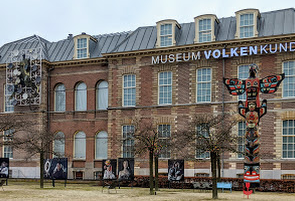
Established 1837
Location Leiden, Netherlands
Coordinates 52.163056°N 4.4825°E
Visitors 76,315 (2008)
Director Steven Engelsman
Website http://volkenkunde.nl
Address and route: Museum Volkenkunde, teenstraat 1, 2312 BS Leiden
The National Museum of Ethnology (Museum Volkenkunde), is an ethnographic museum in the Netherlands located in the university city of Leiden. As of 2014, the museum, along with the Tropenmuseum in Amsterdam, and the Africa Museum in Berg en Dal, together make up the National Museum of World Cultures.
First ethnographic museum in Europe
The institution which was at first called the "Museum Japonicum". It was the first museum in Europe which was designed to demonstrate that collecting the artefacts of man could mean more than the mere accumulation of curiosities. From the very outset, this innovative institution incorporated at least four basic principles: collecting, scientific research, presentation to the public, and educational guidance.
In 1816 the Koninklijk Kabinet van Zeldzaamheden was formed in the Hague as an attempt to start a museum of scientific artifacts from around the world, based on royal collections and a large group of Chinese artifacts from private collections. Thanks to the early efforts of this organization, in the early 1830s, when Philipp Franz Balthasar von Siebold abandoned the political turmoil of revolutionary Belgium for the relative calm of the University of Leiden, he was inspired by the first museum director R.P. van de Kasteele to collect Japanese objects for his collection. The resulting gift of about 5,000 objects became the heart the new museum's holdings. Siebold's home in Leiden—and the objects he brought to Europe after eight years in Japan—was opened to the public in the early 1830s (today his collection is preserved in the SieboldHuis). The Dutch crown had previously purchased the smaller collections of Jan Cock Blomhoff in 1826 and Johannes Gerhard Frederik van Overmeer Fischer in 1832. These which were merged with what Siebold bestowed on King William I; and they became crucial elements in the creation of what became the Museum voor Volkenkunde, or Ethnographic Museum in Leiden in 1837. This institution would later evolve into the National Museum of Ethnology.
In 1843, Siebold also encouraged other Europeans to create ethnographic institutions similar to what was developing in Leiden. He urged "the importance of their creation in European states possessing colonies because these institutions could become a means for understanding the subject peoples and of awakening the interest of the public and of merchants -- all of which are necessary conditions for a lucrative trade which benefits all."
Museum holdings
The collection today contains a large number of objects from Africa, China, Indonesia, Japan, Korea, Latin America, North America, Oceania, and Asia. In developing the collection, the museum has devoted significant attention to acquiring material which illustrates the historical development of world cultures; but the genesis of the museum's holdings began with material garnered during the years Japan was officially closed except for one small island in Nagasaki harbor -- Dejima.
Blomhoff collection
As Opperhoofd (or chief trader) for the Dutch East India Company (Vereenigde Oostindische Compagnie or VOC) at Dejima island in Nagasaki harbor from 1817 through 1823, Jan Cock Blomhoff was unique. Despite the Japanese "closed door" policy for Westerners (sakoku), he did transport his wife, Titia, and children to join him.[6] The Japanese predictably responded by ejecting both Blomhoff and his family; but that experience did broaden the range of household goods and other objects he accumulated across the span of his stay in Japan.
Fischer collection
Johannes Gerhard Frederik van Overmeer Fischer began as a clerk at Dejima and he was later promoted to "Package House Master" (pakhuismeester). During the span of his stay in Japan, Fisher's access to Japanese culture was limited; but within his universe of contacts, he was able to amass a considerable collection of "ordinary" objects which were plausbily overlooked by others. This material was brought back to the Netherlands in 1829. In 1833, he published Bijdrage tot de kennis van het Japansche rijk (Contribution to the knowledge of the Japanese State).
Siebold collection
As a physician practicing Western medicine in Nagasaki (1823-1829), Philipp Franz von Siebold received payment in kind with a variety of objects and artifacts which would later gain unanticipated scholarly attention in Europe. These everyday objects later became the basis of his large ethnographic collection, which consisted of everyday household goods, woodblock prints, tools and hand-crafted objects used by the Japanese people in the late Edo period. Further information relating to this material was published in Siebold's Nippon. His professional interest was especially drawn to implements used in the practice of traditional Japanese medicine.[8] As of 2005, a separate museum located in one of Siebold's former houses, the SieboldHuis, houses part of the collection.
Leiden plate
The Leiden plate is a Maya belt plaque and important historical artifact from Guatemala. It is depicted on the reverse of a one Guatemalan quetzal banknote.
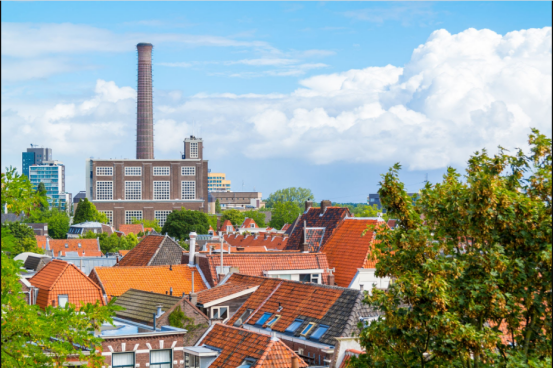
Burcht van Leiden
Type Castle
Site history Built 1100
The Burcht van Leiden is an old shell keep in Leiden constructed in the 11th century. It is located at the spot where two tributaries of the Rhine come together, the Oude Rijn and the Nieuwe Rijn. The structure is on top of a motte, and is today a public park.
History
From humble beginnings, the hill was raised during various periods of history up to 9 meters above the surrounding landscape in the 11th century. Ada van Holland used the keep as a residence until her father died in 1203 and she was captured by her uncle. In the same year the previous stone building was rebuilt after an attack on the castle, with tuff stone, and after Ada's removal, in 1204 it was attacked again and rebuilt with brick.
Later in the 13th century the building was considered antiquated, since more and more townspeople and houses were built around the base of the hill, making defenses impossible without destroying most of the city. The old "interior keep" that had been built against the interior walls (a similar rounded keep construction can still be seen in Teylingen) was slowly dismantled and reused for city construction.
Symbol of Leiden
As the city of Leiden grew around it in the 13th and 14th centuries, the ruined castle lost its military function. The location became a romantic patriotic symbol after the Siege of Leiden in 1574, as historians recalled the earlier sieges of Leiden: Ada in 1203 and the siege in 1420 (Hook and Cod wars). The stained-glass windows number 25 & 26 in the Janskerk (Gouda) designed by the Leiden artist and councilman Isaac van Swanenburg glorifies this history in 1601 by commemorating the latest siege (glass 25, paid for by the Delft city council and featuring William the Silent as liberator) with a comparison to the "historical" story of the Siege of Samaria (glass 26, paid for by the Leiden city council and featuring the text of the biblical story with God as savior). The city of Samaria is portrayed with a watch tower much like the Leidse Burcht.
Public park
In 1651 the city bought the premises to make it into a water tower for public use. A system of waterpipes leading to squares in the city is still intact. In this period a new portal on the keep wall was designed in 1662 with heraldric symbols by Rombout Verhulst, denoting the leading families of the city. There are two other gates to the Burcht, one at the base of the hill with wrought iron heraldric weapons, built in 1653, and one on the south side of the complex, which itself forms a gateway to the park. In this Southern gateway a poem in Latin was used for centuries to teach the rudiments of grammar to Leiden students. A memorial plaque was placed in 1999 with the modern translation in Dutch.
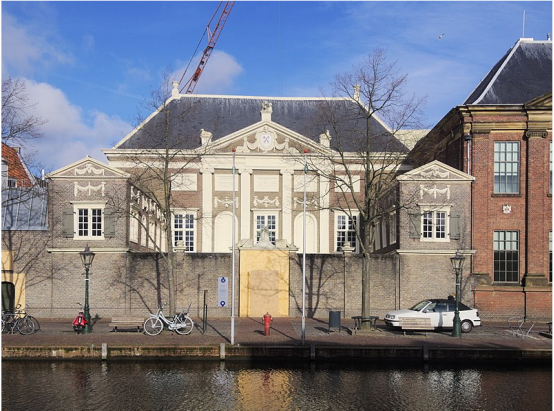
Museum De Lakenhal
Museum De Lakenhal is a city museum of history and fine art in Leiden, Netherlands. One highlight is its collection of fijnschilder paintings from the Dutch Golden Age. The museum regularly hosts visiting art exhibitions and has a café.
History of the building
The museum building was erected in 1640 by Arent van 'Gravesande as a cloth hall (lakenhal in Dutch) – a guild hall for cloth merchants.[1] The museum was founded in 1874 as a stedelijk museum (municipal museum.)
Collections
Like other municipal museums in the Netherlands, it became a repository for municipal art collections. Artifacts from Leiden are on display such as a series of stained glass windows by Willem Thibaut commissioned for the Leiden city hall, are now installed in the stairwells.
On permanent display is also the old inspection room or Staalmeesterskamer where cloth was inspected and the meeting hall where disputes were decided. Four large paintings depicting the cloth industry by Isaac van Swanenburg hang in the same spots on the walls as designed. Similarly, a very grand over-the-mantel piece by Carel de Moor shows the inspectors in a massive wooden frame decorated with their family shields, flanked by a series of three historical allegories of the city of Leiden by Abraham Lambertsz van den Tempel.
The museum hosts a collection of altarpieces and religious artifacts from before the Protestant Revolution that were formally ceded to the state in 1572. The museum also includes a reconstructed statie or Catholic mission station from after the Reformation. Because the Catholic religion was banned, there was no official church and all of the Catholic places of worship in the young Dutch Republic were called mission stations. These were semi-hidden churches that were tolerated and taxed by the state.
Minerva Crowns the Maid of Leiden, one of a series of three grand paintings for the Lakenhal in 1650 by Abraham Lambertsz van den Tempel.
The collection also includes A Pedlar Selling Spectacles (Allegory of Sight), one of a series of five, The Senses, by Rembrandt.
The Museum was closed for restoration and expansion from 2016 to 2019.
After the Museum reopened in June 2019, it displays a newly identified painting by Rembrandt, Let the Children Come to Me, showing Jesus preaching.

Hooglandse Kerk around 1900 (picture by Jan Goedeljee)
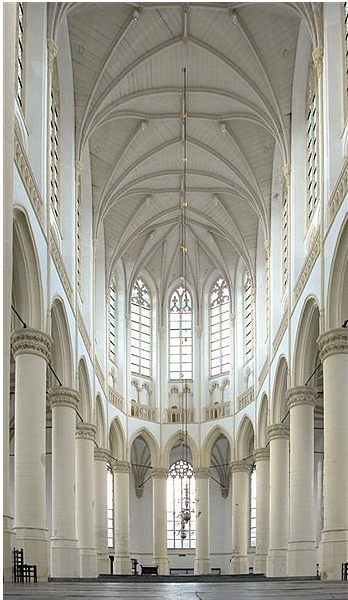
Interior of the Hooglandse Kerk
Location Leiden, Netherlands
Style Gothic architecture
Specifications
Length 70,7 meters
Width 65,7 meters
Church (de Sint Lodewijkskerk)
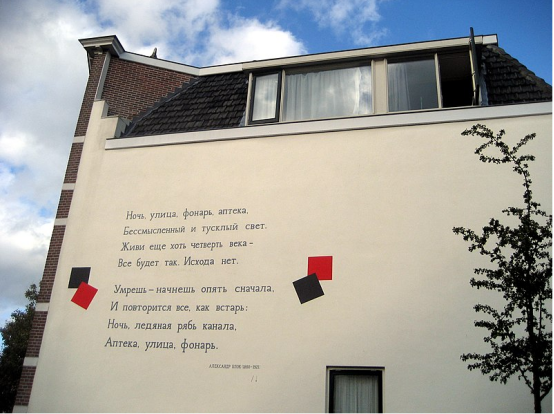
Buildings of interest
Because of the economic decline from the end of the 17th until the middle of the 19th century, much of the 16th- and 17th-century city centre is still intact. It is the second largest 17th-century town centre in the Netherlands, the largest being Amsterdam's city centre.
A hundred buildings in the centre are decorated with large murals of poetry, part of a wall poem project active from 1992, and still ongoing.
Wall poems in Leiden
Wall Poems (Dutch: Muurgedichten, alternatively Gedichten op muren or Dicht op de Muur) is a project in which more than 110 poems in many different languages were painted on the exterior walls of buildings in the city of Leiden, The Netherlands.
History and description
The Wall Poems project was partly funded by the private Tegen-Beeld foundation of Ben Walenkamp and Jan-Willem Bruins, the project's two artists, with additional funding from several corporations and the city of Leiden.[2][4] It began in 1992 with a poem in Russian by Marina Tsvetaeva and (temporarily) finished in 2005 with the Spanish poem De Profundis by Federico García Lorca. Other poets included in the set include E. E. Cummings, Langston Hughes, Jan Hanlo, Du Fu, Louis Oliver, Pablo Neruda, Rainer Maria Rilke, William Shakespeare, and W. B. Yeats, as well as local writers Piet Paaltjens and J. C. Bloem. One of the more obscure poems in the collection is written in the Buginese language on a canal wall near the Royal Netherlands Institute of Southeast Asian and Caribbean Studies; it and many of the other poems are accompanied by plaques with translations into Dutch and English.

Du Fu
University buildings
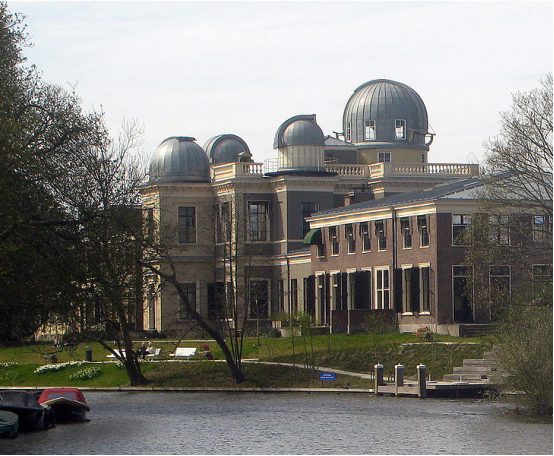
The 1860 Leiden Observatory, after restoration (2013)
The city centre contains many buildings that are in use by the University of Leiden. The Academy Building is housed in a former 16th-century convent. Among the institutions connected with the university are the national institution for East Indian languages, ethnology and geography; the botanical gardens, founded in 1587; the observatory (1860); the museum of antiquities (Rijksmuseum van Oudheden); and the ethnographical museum, of which P. F. von Siebold's Japanese collection was the nucleus (Rijksmuseum voor Volkenkunde). This collection is now housed in a separate museum called the SieboldHuis. The Bibliotheca Thysiana occupies an old Renaissance building of the year 1655. It is especially rich in legal works and vernacular chronicles. Noteworthy are also the many special collections at Leiden University Library among which those of the Society of Dutch Literature (1766) and the collection of casts and engravings. In recent years the university has built the Leiden Bio Science Park at the city's outskirts to accommodate the Science departments.
Other buildings
Stadhuis (City Hall), a 16th-century building that was badly damaged by a fire in 1929 but has its Renaissance façade designed by Lieven de Key still standing
Gemeenlandshuis van Rijnland (1596, restored in 1878)
De Waag (weigh house in Dutch), built by Pieter Post
Gravensteen – a former 15th century jail at the Gerecht square (former court-house)
Stedelijk Gymnasium (aka Latijnse School) – the old gymnasium (1599)
Stadstimmerwerf – the city carpenter's yard and wharf (1612), both built by Lieven de Key (c. 1560–1627)
Heilige Geest Weeshuis (a former Holy Spirit Orphanage) – a complex of 16th century buildings.
Molen de Valk – a corn-grinding windmill, now home to a museum (1743)
Pesthuis, which was built during 1657–1661 at that time just outside the city for curing patients suffering the bubonic plague. However, after it was built the feared disease did not occur in the Netherlands anymore so it was never used for its original purpose. The building has been used as a military hospital, prison, national asylum and army museum. It now serves as the entrance of Naturalis, one of the largest natural history museums in the world.
五、历史文化
Leiden was formed on an artificial hill (today called the Burcht van Leiden) at the confluence of the rivers Oude and Nieuwe Rijn (Old and New Rhine). In the oldest reference to this, from circa 860, the settlement was called Leithon. The name is said to be from Germanic *leitha- "canal" [6] in dative pluralis, thus meaning "at the canals". "Canal" is actually not the completely proper word. A leitha (later "lede") was a human-modified natural river, partly natural, partly artificial.
Leiden has in the past erroneously been associated with the Roman outpost Lugdunum Batavorum. This particular castellum was thought to be located at the Burcht of Leiden, and the city's name was thought to be derived from the Latin name Lugdunum. However the castellum was in fact closer to the town of Katwijk, whereas the Roman settlement near modern-day Leiden was called Matilo.
The landlord of Leiden, situated in a stronghold on the hill (motte), was initially subject to the Bishop of Utrecht but around 1100 the burgraves became subject to the county of Holland. This county got its name in 1101 from a domain near the stronghold: Holtland or Holland.
Leiden was sacked in 1047 by Emperor Henry III. Early 13th century, Ada, Countess of Holland took refuge here when she was fighting in a civil war against her uncle, William I, Count of Holland. He besieged the stronghold and captured Ada.
Leiden received city rights in 1266. In 1389, its population had grown to about 4,000 persons.
Siege of 1420
In 1420, during the Hook and Cod wars, Duke John III of Bavaria along with his army marched from Gouda in the direction of Leiden in order to conquer the city since Leiden did not pay the new Count of Holland Jacqueline, Countess of Hainaut, his niece and only daughter of Count William VI of Holland.
Burgrave Filips of Wassenaar and the other local noblemen of the Hook faction assumed that the duke would besiege Leiden first and send small units out to conquer the surrounding citadels. But John of Bavaria chose to attack the citadels first.
He rolled the cannons along with his army but one which was too heavy went by ship. By firing at the walls and gates with iron balls the citadels fell one by one. Within a week John of Bavaria conquered the castles of Poelgeest, Ter Does, Hoichmade, de Zijl, ter Waerd, Warmond and de Paddenpoel.
On 24 June the army appeared before the walls of Leiden. On 17 August 1420, after a two-month siege the city surrendered to John of Bavaria. The burgrave Filips of Wassenaar was stripped of his offices and rights and lived out his last years in captivity.
16th to 18th centuries
Leiden flourished in the 16th and 17th century. At the close of the 15th century the weaving establishments (mainly broadcloth) of Leiden were very important. After the expulsion of the Spaniards, Leiden cloth, Leiden baize and Leiden camlet were familiar terms.[citation needed] In the same period, Leiden developed an important printing and publishing industry. The influential printer Christoffel Plantijn lived there at one time. One of his pupils was Lodewijk Elzevir (1547–1617), who established the largest bookshop and printing works in Leiden, a business continued by his descendants through 1712 and the name subsequently adopted (in a variant spelling) by contemporary publisher Elsevier.[citation needed]
In 1572, the city sided with the Dutch revolt against Spanish rule and played an important role in the Eighty Years' War. Besieged from May until October 1574 by the Spanish, Leiden was relieved by the cutting of the dikes, thus enabling ships to carry provisions to the inhabitants of the flooded town. As a reward for the heroic defence of the previous year, the University of Leiden was founded by William I of Orange in 1575. Yearly on 3 October, the end of the siege is still celebrated in Leiden. Tradition tells that the citizens were offered the choice between a university and a certain exemption from taxes and chose the university. The siege is notable also for being the first instance in Europe of the issuance of paper money, with paper taken from prayer books being stamped using coin dies when silver ran out.
Leiden is also known as the place where the Pilgrims (as well as some of the first settlers of New Amsterdam) lived (and operated a printing press) for a time in the early 17th century before their departure to Massachusetts and New Amsterdam in the New World.
In the 17th century, Leiden prospered, in part because of the impetus to the textile industry by refugees from Flanders. While the city had lost about a third of its 15,000 citizens during the siege of 1574, it quickly recovered to 45,000 inhabitants in 1622, and may have come near to 70,000 circa 1670. During the Dutch Golden Era, Leiden was the second largest city of Holland, after Amsterdam.[citation needed] Particularly due to the work by Herman Boerhaave (1668–1738), it played a crucial role in the establishment of modern chemistry and medicine.
From the late 17th century onwards Leiden slumped, mainly due to the decline of the cloth industries. In the beginning of the 19th century the baize manufacture was altogether given up, although industry remained central to Leiden economy. This decline is painted vividly by the fall in population. The population of Leiden had sunk to 30,000 between 1796 and 1811, and in 1904 was 56,044.[citation needed]
From the 17th to the early 19th century, Leiden was the publishing place of one of the most important contemporary journals, Nouvelles Extraordinaires de Divers Endroits, known also as Gazette de Leyde.
19th and 20th centuries
On 12 January 1807, a catastrophe struck the city when a boat loaded with 17,400 kilograms (38,360 pounds) of gunpowder blew up in the middle of Leiden. 151 persons were killed, over 2,000 were injured and some 220 homes were destroyed. King Louis Bonaparte personally visited the city to provide assistance to the victims. Although located in the centre of the city, the area destroyed remained empty for many years. In 1886 the space was turned into a public park, the Van der Werff park.
In 1842, the railroad from Leiden to Haarlem was inaugurated and one year later the railway to Den Haag was completed, resulting in some social and economic improvement. Perhaps the most important piece of Dutch history contributed by Leiden was the Constitution of the Netherlands. Johan Rudolf Thorbecke (1798–1872) wrote the Dutch Constitution in April 1848 in his house at Garenmarkt 9 in Leiden.
Leiden's reputation as the "city of books" continued through the 19th century with the establishment of publishing dynasties by Evert Jan Brill and Albertus Willem Sijthoff. Sijthoff, who rose to prominence in the trade of translated books, wrote a letter in 1899 to Queen Wilhelmina regarding his opposition to becoming a signatory to the Berne Convention for the Protection of Literary and Artistic Works. He felt that international copyright restrictions would stifle the Dutch publishing industry.
Leiden grew 12-fold in size between 1896 and 1981, annexing land from neighboring municipalities
Leiden began to expand beyond its 17th-century moats around 1896 and the number of citizens surpassed 50,000 in 1900. After 1920, new industries were established in the city, such as the canning and metal industries. During World War II, Leiden was hit hard by Allied bombardments. The areas surrounding the railway station and Marewijk were almost completely destroyed.
Leiden today
The city's biggest and most popular annual festival is celebrated at 3 October and is called simply 3 Oktober. The people of Leiden celebrate the end of the Spanish siege of 1574. It typically takes place over the course of two to three days (usually two but three if there's a Sunday involved) and includes parades, a hutspot feast, historical reenactments, a funfair and other events. The city has recently started to host the Leiden International Film Festival, the fastest growing festival of its type in the Netherlands.
Leiden has important functions as a shopping and trade centre for communities around the city. The University of Leiden is famous for its many discoveries including Snells law (by Willebrord Snellius), the famous Leyden jar, a capacitor made from a glass jar, invented in Leiden by Pieter van Musschenbroek in 1746. Another development was in cryogenics: Heike Kamerlingh Onnes (1913 Nobel prize winner in physics) liquefied helium for the first time (1908) and later managed to reach a temperature of less than one degree above the absolute minimum. Albert Einstein also spent some time at Leiden University during his early to middle career.
The city also houses the Eurotransplant, the international organization responsible for the mediation and allocation of organ donation procedures in Austria, Belgium, Croatia, Germany, Luxembourg, the Netherlands and Slovenia. Leiden also houses the headquarters of Airbus, a global pan-European aerospace and defence corporation and a leading defence and military contractor worldwide. The group includes Airbus, the leading manufacturer of commercial aircraft worldwide.
六、其他信息
The coat of arms of Leiden is two red keys, crossed in an X-shape on a white background. These keys are the Keys of Heaven held by St. Peter, for whom a large church in the city centre is named. Because of this coat of arms, Leiden is referred to as the "Sleutelstad" ("the key city").
For a time Leiden held the title "The Coldest Place on Earth" because of the developments in cryogenics in a laboratory there. Heike Kamerlingh Onnes (1913 Nobel prize winner in physics) liquefied helium for the first time (1908), and later managed to reach a temperature of less than one degree above Absolute zero.
The Norwegian cheese "nøkkelost" ("key cheese") is named after the keys in coat of arms of Leyden, as it is a variation of Leyden cheese.
Leiden's Stadhuis (Town Hall) has a poem in the form of a cryptogram on its façade that records the date 1574 in Roman numerals, the year of the "Black Famine" or Spanish siege (W equals two Vs):
Nae zWarte HVnger-noot
GebraCht had tot de doot
bInaest zes-dVIzent MensChen;
aLst god den heer Verdroot
gaf hI Vns Weder broot
zo VeeL WI CVnsten WensChen.
七、联系方式
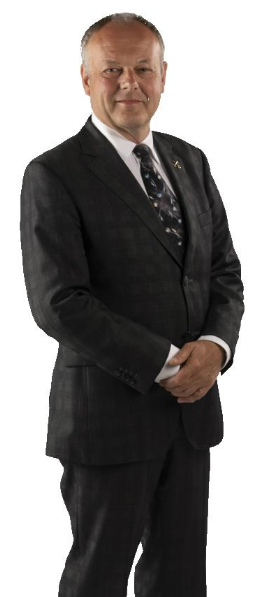
Mayor Henri Lenferink
Send an email to the mayor: h.lenferink@leiden.nl
Call the secretariat for appointments: 071 - 5165025
Board advisor : Femke Osinga, f.osinga@leiden.nl
Press information: 071 - 5165055 or send an email to press information: persvoorlichting@leiden.nl
Spokesperson: Willemijn Faber, w.faber@leiden.nl or call 06 - 31675936 .
Mailing address
General
PO Box 9100, 2300 PC Leiden
Parking Department
PO Box 495, 2300 AL Leiden
City Bank Department
PO Box 11300, 2301 EH Leiden
Work and Income Department
PO Box 9102, 2300 PC Leiden
by phone 14 071
From abroad +31 71 516 51 65
WhatsApp 06 - 30 69 63 84
Facebook: Gemeente Leiden @gemeenteleiden
Twitter: Gemeente Leiden
@GemeenteLeiden
https://gemeente.leiden.nl
